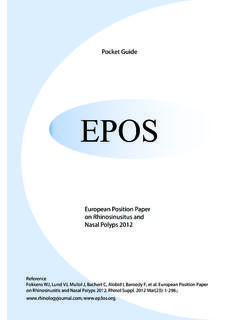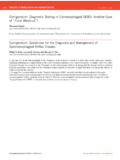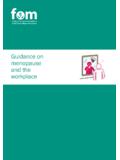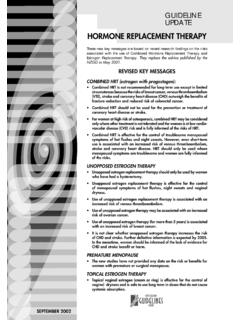Transcription of GUIDELINES FOR MANAGEMENT OF ADVERSE …
1 NATIONAL 111I01502 GUIDELINES FOR MANAGEMENT OF ADVERSE transfusion reactions Author: Jim Faed Effective Date: 26/08/2014 Page 1 of 8 Authoriser: Peter Flanagan Previous ID: 111I01501 QA Approver: Meredith Smith REACTION/CAUSE SIGNS & SYMPTOMS PREVENTION MANAGEMENT Febrile (non haemolytic) transfusion Reaction (FNHTR) Frequency: 1-3:100 (higher in multi transfused recipients) Common Onset during or within 4 hours following transfusion Reaction induced by cytokines Other causes may exist Mild: unexplained fever 38 C and a temperature rise of at least 1 C but < C from pre- transfusion baseline, occurring in the absence of chills, rigors, respiratory distress and haemodynamic instability Moderate: unexplained fever 38 C and a temperature rise of at least 1 C but not meeting criteria for either mild or severe FNHTR Severe: unexplained fever >39 C and a temperature rise C from pre- transfusion baseline and chills/rigors Associated or secondary symptoms may be present: tachycardia, headache, nausea, flushing, anxiety, hypertension or occasionally hypotension In severe cases: marked apprehension, loin pain, and/or angina Check for history of previous transfusion reactions .
2 Consider pre- transfusion antipyretic Paracetamol 1g po where minor reactions occur and further transfusions are required Consult TMS if recurrent reactions occur Note: all blood components are leucocyte-depleted during production. Further leucodepletion at the bedside is not required Check label and recipient identity Slow the transfusion if reaction is mild and MO elects to continue transfusion Send Haemovigilance notification to Blood Bank Antipyretic Paracetamol 1g po and monitor closely Steroids are not appropriate treatment for minor reactions NATIONAL 111I01502 GUIDELINES FOR MANAGEMENT OF ADVERSE transfusion reactions Page 2 of 8 REACTION/CAUSE SIGNS & SYMPTOMS PREVENTION MANAGEMENT Allergic Reaction (minor) Frequency: 1:100 - 1:500 More common with Plasma and Platelet Components Onset: from commencement to 4 hours after transfusion Recipient may have an antibody reacting with an antigen in the transfused product Minor or localised reaction.
3 Flushed skin Morbilliform rash with itching Urticaria (hives) Angioedema Periorbital itch, erythema and oedema Conjunctival oedema Minor oedema of lips, tongue and uvula For recurrent mild reactions prophylaxis with antihistamine to alleviate symptoms, eg Loratadine 10mg or Cetirizine 10mg po Routine prophylaxis for all recipients before transfusion is not indicated Slow transfusion Check label and recipient identity Antihistamine, eg Loratadine 10mg or Cetirizine 10mg po if symptoms are troublesome If symptoms mild and transient, transfusion may resume Continue transfusion at a slower rate with increased monitoring, eg BP/TPR 15 30min Send Haemovigilance notification to Blood Bank If symptoms increase treat as a moderate or severe reaction Allergic Reaction (moderate) Frequency: 1:500 1:5,000 Onset usually within first 50-100 mL infused and within 4 hours of transfusion Recipient may have an antibody reacting with a plasma protein or leucocyte antigen (HLA or other) in the transfused product Moderate or widespread reaction: Symptoms as for minor reactions , and - Cough Hypotension and tachycardia Dyspnoea and oxygen desaturation are common Chills and rigors Loin pain and angina Severe anxiety Discuss with TMS if recurrent.
4 Note: Prophylactic treatment with an antihistamine or hydrocortisone will not reliably prevent moderate and severe allergic reactions but may alleviate symptoms when present Stop transfusion Check label and recipient identity Replace IV set and give saline to keep vein open and/or maintain BP Monitor closely and treat symptomatically as required with IV fluids, oxygen and antihistamine, eg Promethazine 25-50 mg IV (max rate 25 mg/min) or Loratadine 10mg or Cetirizine 10mg po. Hydrocortisone may be considered Send Haemovigilance notification to Blood Bank Discuss with TMS promptly if mod -severe reaction present NATIONAL 111I01502 GUIDELINES FOR MANAGEMENT OF ADVERSE transfusion reactions Page 3 of 8 REACTION/CAUSE SIGNS & SYMPTOMS PREVENTION MANAGEMENT Anaphylactic / Anaphylactoid Allergic Reaction (severe) Frequency: 1:20,000 1:50,000 Rapid onset May be due to an antibody in the recipient reacting with a plasma protein in a blood component o IgA o Haptoglobin o Other plasma protein Life-threatening reaction: Symptoms as for moderate reactions , and - Severe hypotension, shock and tachycardia Widespread urticaria with skin flushing and itching Wheezing, stridor, change in voice Severe anxiety Note.
5 Respiratory symptoms may dominate in anaesthetised recipients Discuss with TMS before requesting: IgA deficient blood/blood products may be appropriate if recipient is known to have absolute IgA deficiency or to have anti-IgA Washed cellular components may be indicated where the cause of the reaction is not identified Stop transfusion Check label and recipient identity Follow Anaphylaxis GUIDELINES : o Adrenalin 1:1000 IM and repeat at 5-10 min intervals if required: - Adult: / mL - Children IM; min dose , max dose o Replace IV set and give rapid IV colloid or saline, eg adults 2 L, children 20 mL/kg, until SBP>90 mmHg, then titrate o Consider Hydrocortisone 4mg/kg (200-400 mg IV) o Consider H1-antihistamine, eg Loratadine or Cetirizine 10 mg po for itch or angioedema. o H2-antihistamine, eg Ranitidine may be added for severe reactions .
6 O Note: Sedating antihistamines, eg Promethazine contraindicated CPAP ventilation, chest X-ray ICU liaison Follow NZRC GUIDELINES if no pulse present and for symptoms that persist after initial treatment Collect serum tryptase sample within 1-2 h if anaphylaxis may be present (returns to normal within 6-8 h) Send Haemovigilance notification to Blood Bank Discuss severe reactions with TMS NATIONAL 111I01502 GUIDELINES FOR MANAGEMENT OF ADVERSE transfusion reactions Page 4 of 8 REACTION/CAUSE SIGNS & SYMPTOMS PREVENTION MANAGEMENT Hypotensive Reaction Frequency: 1-2:1,000 Often idiosyncratic reaction Hypotension fall in systolic BP >30 mm Hg during or within 1 h of completing transfusion and systolic BP <80 mm Hg Stop transfusion Replace the IV infusion set and infuse saline to manage BP Symptomatic MANAGEMENT until resolved Send Haemovigilance notification to Blood Bank Acute Haemolytic Reaction Frequency: 1:12,000 1.
7 100,000 Onset within 24 hours, usually immediate ABO or other incompatible red cell transfusion reaction caused by complement-fixing antibodies Rarely ABO antibodies in a platelet or plasma component or Improper handling and storage of blood Some or all of Unexplained fever >1oC Chills, rigors Pain up arm Chest, abdominal or low back pain Dyspnoea Tachycardia Hypotension, shock Haemoglobinaemia and haemoglobinuria Oliguria with dark urine or anuria Nausea, vomiting Diarrhoea Pallor, jaundice Bleeding (due to DIC) Meticulous checking of recipient s ID and labeling of pre- transfusion blood sample at recipient s side Meticulous two-person checking of ID of intended recipient of blood component and component label Careful monitoring of recipient for first 15 min of each unit transfused Store and handle blood components within specifications Stop transfusion Check label and recipient identify Replace IV set and start normal saline Treat shock and maintain blood pressure with IV saline infusion Investigate possible DIC and treat if clinically significant bleeding Diuretic, eg Frusemide 1-2 mg/kg IV and/or Mannitol, may help maintain urine flow Hydrocortisone may be considered Samples to assess renal and liver function, DIC and haemolysis, eg full blood count, unconjugated bilirubin.
8 LDH and haptoglobin Send Haemovigilance notification to Blood Bank NATIONAL 111I01502 GUIDELINES FOR MANAGEMENT OF ADVERSE transfusion reactions Page 5 of 8 REACTION/CAUSE SIGNS & SYMPTOMS PREVENTION MANAGEMENT Delayed Haemolytic Reaction Frequency: Estimated 1:5,000 but recognized and reported events 1:35,000 Onset usually 1-7 days post transfusion but may be up to 28 days Recipient has previously been immunised to a blood group antigen, usually by transfusion or pregnancy. transfusion with red cells expressing the relevant antigen produces a secondary immune response and results in haemolysis of transfused antigen-positive red cells Worsening anaemia and jaundice from destruction of red cells Often asymptomatic but rarely splenomegaly, haemoglobinaemia and haemoglobinuria Renal impairment may occur in severe cases Blood screen shows unexpected anaemia and spherocytes may be present on film Blood group antibodies are recorded on the NZ Blood Service national database so that compatible red cell components can be provided for future transfusions Note.
9 Delay may occur when providing compatible red cells for transfusion Investigate haemolysis: Full blood count with film comment Direct antiglobulin test (may be negative when most red cells cleared) Blood group antibody screen (may be negative until red cells cleared) Liver function tests Haptoglobin concentration falls while haemolysis is occurring LDH Send Haemovigilance notification to Blood Bank if reaction is suspected Bacterial Sepsis Frequency: Platelet components: <1:10,000 Red cell components: <1:250,000 Rapid onset Blood component contains bacteria that have grown to a high concentration Most commonly affects platelet components; rarely affects red cells If gram negative bacteria are present, endotoxin levels may be very high Rigor, chills, fever Shock, usually within minutes of starting transfusion Respiratory distress, wheezing and oxygen desaturation Pain up arm Chest and back / loin pain Nausea, vomiting Explosive diarrhoea may occur with Yersinia enterocolitica sepsis Most common infecting agents: staphylococcal species (platelet components), gram negative species (red cell components) Collect, store and handle blood components within specifications Inspect products for any visual abnormality or defect in unit container before transfusing: o a visibly clumped platelet component o an unusually dark red cell component o punctured or leaking bag Stop transfusion Replace IV set.
10 Give saline to maintain BP and/or keep vein open Send Haemovigilance notification to Blood Bank Notify Blood Bank by phone and contact TMS urgently Obtain blood cultures from recipient if sepsis suspected Give antibiotics: a broad-spectrum penicillin or cephalosporin and gentamicin 5mg/kg Note: Blood Bank will arrange urgent Gram stain and cultures on blood component and report any positive findings NATIONAL 111I01502 GUIDELINES FOR MANAGEMENT OF ADVERSE transfusion reactions Page 6 of 8 REACTION/CAUSE SIGNS & SYMPTOMS PREVENTION MANAGEMENT TACO: transfusion Associated Circulatory Overload Frequency: 1:100-1:1,000 red cell transfusion episodes Rapid onset after infusion of a volume of fluid that is clinically significant for the affected recipient. Main risk factors: o Elderly recipient with impaired cardiovascular state or renal impairment o Infusion too rapid for recipient o Volume infused too great, especially if normovolaemic Increased blood pressure Rapid bounding pulse Respiratory distress with raised resp.







